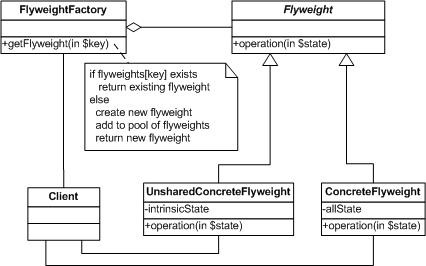PHP设计模式笔记:使用PHP实现合成模式
【意图】
将对象组合成树形结构以表示”部分-整体”的层次结构。Composite使用户对单个对象和组合对象的使用具有一致性。
Composite变化的是一个对象的结构和组成
【合成模式中主要角色】
抽象组件(Component)角色:抽象角色,给参加组合的对象规定一个接口。在适当的情况下,实现所有类共有接口的缺省行为。声明一个接口用于访问和管理Component的子组件
树叶组件(Leaf)角色:在组合中表示叶节点对象,叶节点没有子节点。在组合中定义图元对象的行为。
树枝组件(Composite)角色:存储子部件。定义有子部件的那些部件的行为。在Component接口中实现与子部件有关的操作。
客户端(Client):通过Component接口操纵组合部件的对象
【合成模式的优点和缺点】
Composite模式的优点
1、简化客户代码
2、使得更容易增加新类型的组件
Composite模式的缺点:使你的设计变得更加一般化,容易增加组件也会产生一些问题,那就是很难限制组合中的组件
【合成模式适用场景】
1、你想表示对象的部分-整体层次结构
2、你希望用户忽略组合对象和单个对象的不同,用户将统一地使用组合结构中的所有对象。
【合成模式与其它模式】
装饰器模式:Decorator模式经常与Composite模式一起使用。当装饰与合成一起使用时,它们通常有一个公共的父类。因此装饰必须支持具有add,remove和getChild操作的Component接口
享元模式:Flyweight模式让你共享组件,但不再引用他们的父部件
迭代器模式:Itertor可用来遍历Composite
访问者模式:Visitor将本来应该分布在Composite和Leaf类中的操作和行为局部化。
【安全式的合成模式】
在Composite类里面声明所有的用来管理子类对象的方法。这样的做法是安全的。因为树叶类型的对象根本就没有管理子类的方法,因此,如果客户端对树叶类对象使用这些方法时,程序会在编译时期出错。编译通不过,就不会出现运行时期错误
这样的缺点是不够透明,因为树叶类和合成类将具有不同的接口。
【安全式的合成模式结构图】
【安全式的合成模式PHP示例】
1 2 3 4 5 6 7 8 9 10 11 12 13 14 15 16 17 18 19 20 21 22 23 24 25 26 27 28 29 30 31 32 33 34 35 36 37 38 39 40 41 42 43 44 45 46 47 48 49 50 51 52 53 54 55 56 57 58 59 60 61 62 63 64 65 66 67 68 69 70 71 72 73 74 75 76 77 78 79 80 81 82 83 84 85 86 87 88 89 90 91 92 93 94 95 96 97 98 99 100 101 102 103 104 105 106 107 108 109 110 111 112 113 114 115 116 117 118 119 120 121 122 123 124 125 126 127 | <?php /** * 安全的合成模式的PHP实现 2010-08-10 sz * @author 胖子 phppan.p#gmail.com http://www.phppan.com * 哥学社成员(http://www.blog-brother.com/) * @package design pattern */ /** * 抽象组件角色 */ interface Component { /** * 返回自己的实例 */ public function getComposite(); /** * 示例方法 */ public function operation(); } /** * 树枝组件角色 */ class Composite implements Component { private $_composites; public function __construct() { $this->_composites = array(); } public function getComposite() { return $this; } /** * 示例方法,调用各个子对象的operation方法 */ public function operation() { echo 'Composite operation begin:<br />'; foreach ($this->_composites as $composite) { $composite->operation(); } echo 'Composite operation end:<br /><br />'; } /** * 聚集管理方法 添加一个子对象 * @param Component $component 子对象 */ public function add(Component $component) { $this->_composites[] = $component; } /** * 聚集管理方法 删除一个子对象 * @param Component $component 子对象 * @return boolean 删除是否成功 */ public function remove(Component $component) { foreach ($this->_composites as $key => $row) { if ($component == $row) { unset($this->_composites[$key]); return TRUE; } } return FALSE; } /** * 聚集管理方法 返回所有的子对象 */ public function getChild() { return $this->_composites; } } class Leaf implements Component { private $_name; public function __construct($name) { $this->_name = $name; } public function operation() { echo 'Leaf operation ', $this->_name, '<br />'; } public function getComposite() { return null; } } /** * 客户端 */ class Client { /** * Main program. */ public static function main() { $leaf1 = new Leaf('first'); $leaf2 = new Leaf('second'); $composite = new Composite(); $composite->add($leaf1); $composite->add($leaf2); $composite->operation(); $composite->remove($leaf2); $composite->operation(); } } Client::main(); ?> |
【透明式的合成模式】
在Composite类里面声明所有的用来管理子类对象的方法。这样做的是好处是所有的组件类都有相同的接口。在客户端看来,树叶类和合成类对象的区别起码在接口层次上消失了,客户端可以同等的对待所有的对象。这就是透明形式的合成模式
缺点就是不够安全,因为树叶类对象和合成类对象在本质上是有区别的。树叶类对象不可能有下一个层次的对象,因此调用其添加或删除方法就没有意义了,这在编译期间是不会出错的,而只会在运行时期才会出错。
【透明式的合成模式结构图】
【透明式的合成模式PHP示例】
1 2 3 4 5 6 7 8 9 10 11 12 13 14 15 16 17 18 19 20 21 22 23 24 25 26 27 28 29 30 31 32 33 34 35 36 37 38 39 40 41 42 43 44 45 46 47 48 49 50 51 52 53 54 55 56 57 58 59 60 61 62 63 64 65 66 67 68 69 70 71 72 73 74 75 76 77 78 79 80 81 82 83 84 85 86 87 88 89 90 91 92 93 94 95 96 97 98 99 100 101 102 103 104 105 106 107 108 109 110 111 112 113 114 115 116 117 118 119 120 121 122 123 124 125 126 127 128 129 130 131 132 133 134 135 136 137 138 139 140 141 142 143 144 145 146 147 148 149 150 151 152 153 154 155 156 157 158 159 160 161 162 163 164 165 166 167 168 169 170 171 172 | <?php /** * 透明的合成模式的PHP实现 2010-08-10 sz * @author 胖子 phppan.p#gmail.com http://www.phppan.com * 哥学社成员(http://www.blog-brother.com/) * @package design pattern */ /** * 抽象组件角色 */ interface Component { /** * 返回自己的实例 */ public function getComposite(); /** * 示例方法 */ public function operation(); /** * 聚集管理方法 添加一个子对象 * @param Component $component 子对象 */ public function add(Component $component); /** * 聚集管理方法 删除一个子对象 * @param Component $component 子对象 * @return boolean 删除是否成功 */ public function remove(Component $component); /** * 聚集管理方法 返回所有的子对象 */ public function getChild(); } /** * 树枝组件角色 */ class Composite implements Component { private $_composites; public function __construct() { $this->_composites = array(); } public function getComposite() { return $this; } /** * 示例方法,调用各个子对象的operation方法 */ public function operation() { echo 'Composite operation begin:<br />'; foreach ($this->_composites as $composite) { $composite->operation(); } echo 'Composite operation end:<br /><br />'; } /** * 聚集管理方法 添加一个子对象 * @param Component $component 子对象 */ public function add(Component $component) { $this->_composites[] = $component; } /** * 聚集管理方法 删除一个子对象 * @param Component $component 子对象 * @return boolean 删除是否成功 */ public function remove(Component $component) { foreach ($this->_composites as $key => $row) { if ($component == $row) { unset($this->_composites[$key]); return TRUE; } } return FALSE; } /** * 聚集管理方法 返回所有的子对象 */ public function getChild() { return $this->_composites; } } class Leaf implements Component { private $_name; public function __construct($name) { $this->_name = $name; } public function operation() { echo 'Leaf operation ', $this->_name, '<br />'; } public function getComposite() { return null; } /** * 聚集管理方法 添加一个子对象,此处没有具体实现,仅返回一个FALSE * @param Component $component 子对象 */ public function add(Component $component) { return FALSE; } /** * 聚集管理方法 删除一个子对象 * @param Component $component 子对象 * @return boolean 此处没有具体实现,仅返回一个FALSE */ public function remove(Component $component) { return FALSE; } /** * 聚集管理方法 返回所有的子对象 此处没有具体实现,返回null */ public function getChild() { return null; } } /** * 客户端 */ class Client { /** * Main program. */ public static function main() { $leaf1 = new Leaf('first'); $leaf2 = new Leaf('second'); $composite = new Composite(); $composite->add($leaf1); $composite->add($leaf2); $composite->operation(); $composite->remove($leaf2); $composite->operation(); } } Client::main(); ?> |
可以看到透明式合成模式的Leaf有各聚集管理方法的平庸实现



